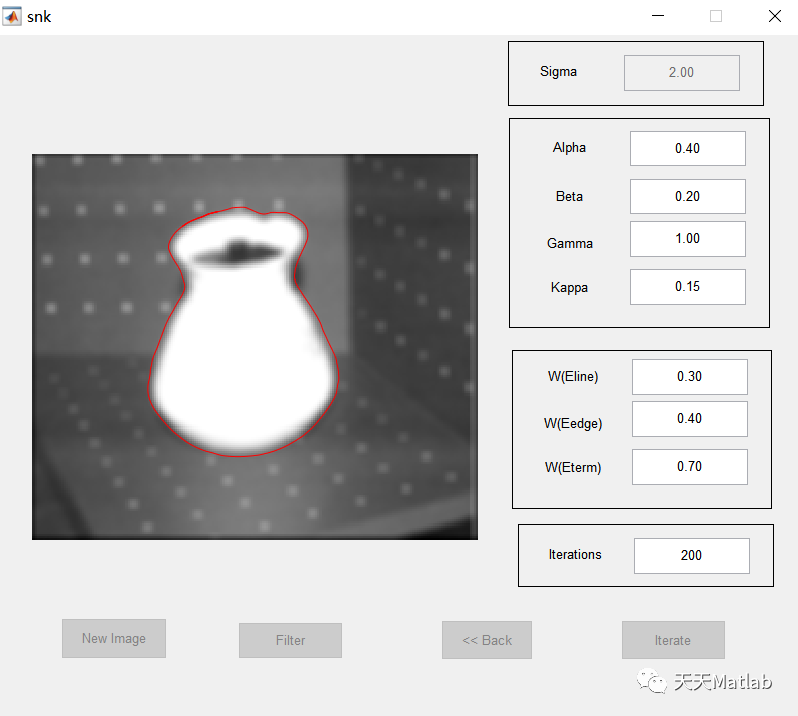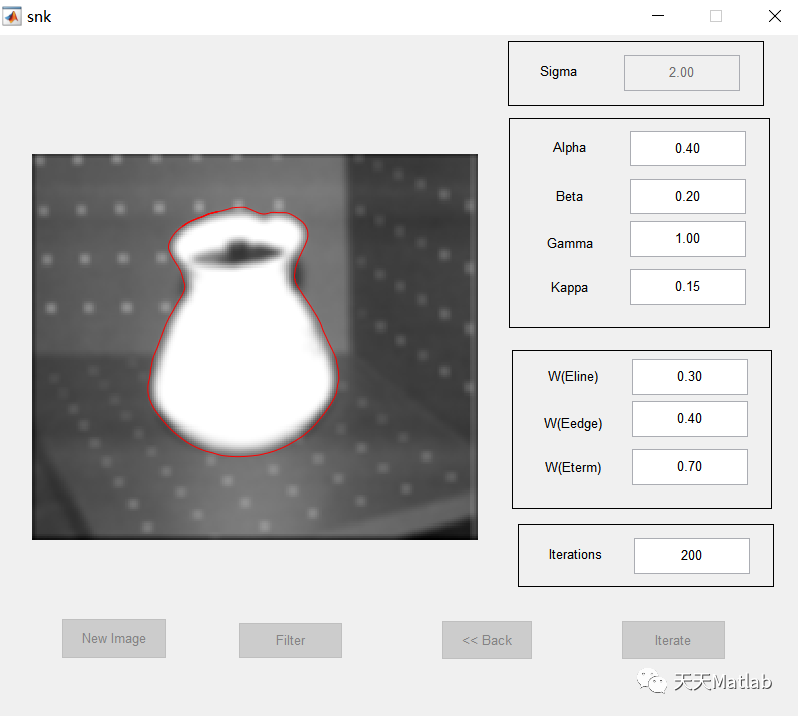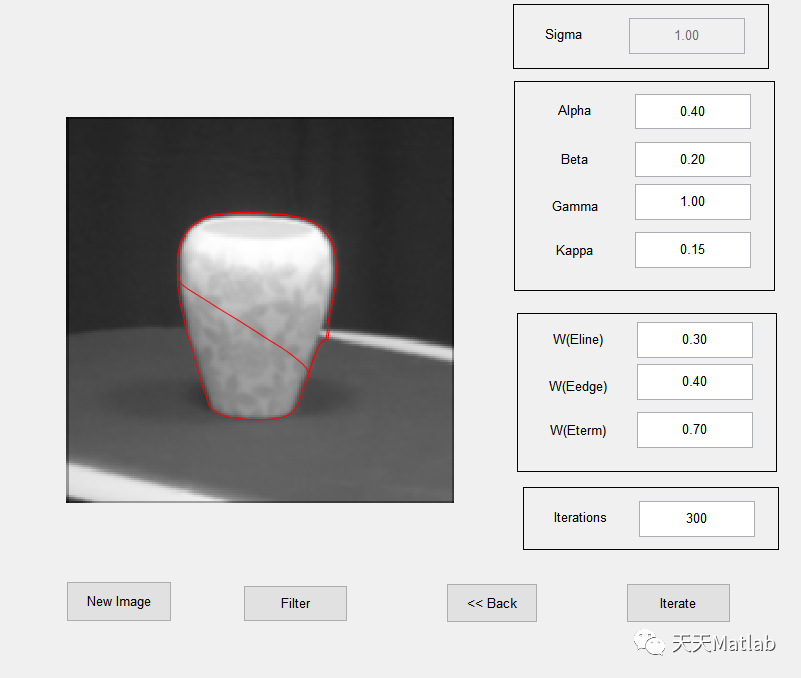
✅作者简介:热爱科研的Matlab仿真开发者,修心和技术同步精进,matlab项目合作可私信。
🍎个人主页:Matlab科研工作室
🍊个人信条:格物致知。
更多Matlab仿真内容点击👇
⛄ 内容介绍
主动轮廓模型算法是目前流行的图像分割算法, 其主要优点是无论图像的质量如何, 总可以抽取得到光滑、封闭的边界. 本文综述了主动轮廓模型算法的发展概况, 并分类介绍了各算法的特点. 此外, 本文还给出了算法发展的方向, 以及今后研究所面临的关键问题.
⛄ 部分代码
%%%%%%%%%%%%%%%%%%%%%%%%%%%%%%%%%%%%%%%%%%%%%%%%%%%%%%%%%%%%%%%%%%%%%%%%%%%
% interate.m implements the core of the snakes (active contours) algorithm.
% It is called by the snk.m file which is the GUI frontend. If you do not
% want to deal with GUI, look at this file and the included comments which
% explain how active contours work.
%
% To run this code with GUI
% 1. Type guide on the matlab prompt.
% 2. Click on "Go to Existing GUI"
% 3. Select the snk.fig file in the same directory as this file
% 4. Click the green arrow at the top to launch the GUI
%
% Once the GUI has been launched, you can use snakes by
% 1. Click on "New Image" and load an input image. Samples image are
% provided.
% 2. Set the smoothing parameter "sigma" or leave it at its default value
% and click "Filter". This will smooth the image.
% 3. As soon as you click "Filter", cross hairs would appear and using
% them and left click of you mouse you can pick initial contour location
% on the image. A red circle would appead everywhere you click and in
% most cases you should click all the way around the object you want to
% segement. The last point must be picked using a right-click in order to
% stop matlab for asking for more points.
% 4. Set the various snake parameters (relative weights of energy terms
% in the snake objective function) or leave them with their default value
% and click "Iterate" button. The snake would appear and move as it
% converges to its low energy state.
%%%%%%%%%%%%%%%%%%%%%%%%%%%%%%%%%%%%%%%%%%%%%%%%%%%%%%%%%%%%%%%%%%%%%%%%%%%
function [smth] = interate(image, xs, ys, alpha, beta, gamma, kappa, wl, we, wt, iterations);
% image: This is the image data
% xs, ys: The initial snake coordinates
% alpha: Controls tension
% beta: Controls rigidity
% gamma: Step size
% kappa: Controls enegry term
% wl, we, wt: Weights for line, edge and terminal enegy components
% iterations: No. of iteration for which snake is to be moved
%parameters
N = iterations;
smth = image;
% Calculating size of image
[row col] = size(image);
%Computing external forces
eline = smth; %eline is simply the image intensities
[grady,gradx] = gradient(smth);
eedge = -1 * sqrt ((gradx .* gradx + grady .* grady)); %eedge is measured by gradient in the image
%masks for taking various derivatives
m1 = [-1 1];
m2 = [-1;1];
m3 = [1 -2 1];
m4 = [1;-2;1];
m5 = [1 -1;-1 1];
cx = conv2(smth,m1,'same');
cy = conv2(smth,m2,'same');
cxx = conv2(smth,m3,'same');
cyy = conv2(smth,m4,'same');
cxy = conv2(smth,m5,'same');
for i = 1:row
for j= 1:col
% eterm as deined in Kass et al Snakes paper
eterm(i,j) = (cyy(i,j)*cx(i,j)*cx(i,j) -2 *cxy(i,j)*cx(i,j)*cy(i,j) + cxx(i,j)*cy(i,j)*cy(i,j))/((1+cx(i,j)*cx(i,j) + cy(i,j)*cy(i,j))^1.5);
end
end
% imview(eterm);
% imview(abs(eedge));
eext = (wl*eline + we*eedge -wt * eterm); %eext as a weighted sum of eline, eedge and eterm
[fx, fy] = gradient(eext); %computing the gradient
%initializing the snake
xs=xs';
ys=ys';
[m n] = size(xs);
[mm nn] = size(fx);
%populating the penta diagonal matrix
A = zeros(m,m);
b = [(2*alpha + 6 *beta) -(alpha + 4*beta) beta];
brow = zeros(1,m);
brow(1,1:3) = brow(1,1:3) + b;
brow(1,m-1:m) = brow(1,m-1:m) + [beta -(alpha + 4*beta)]; % populating a template row
for i=1:m
A(i,:) = brow;
brow = circshift(brow',1)'; % Template row being rotated to egenrate different rows in pentadiagonal matrix
end
[L U] = lu(A + gamma .* eye(m,m));
Ainv = inv(U) * inv(L); % Computing Ainv using LU factorization
%moving the snake in each iteration
for i=1:N;
ssx = gamma*xs - kappa*interp2(fx,xs,ys);
ssy = gamma*ys - kappa*interp2(fy,xs,ys);
%calculating the new position of snake
xs = Ainv * ssx;
ys = Ainv * ssy;
%Displaying the snake in its new position
imshow(image,[]);
hold on;
plot([xs; xs(1)], [ys; ys(1)], 'r-');
hold off;
pause(0.001)
end;
⛄ 运行结果


⛄ 参考文献
[1]吴北海. 基于主动轮廓模型的医学图像分割[D]. 河北工业大学.
[2]高梅, and 余轮. "基于主动轮廓模型的图像分割算法." 漳州师范学院学报(自然科学版) (2007).
❤️ 关注我领取海量matlab电子书和数学建模资料
❤️部分理论引用网络文献,若有侵权联系博主删除























 779
779











 被折叠的 条评论
为什么被折叠?
被折叠的 条评论
为什么被折叠?










